Multi-stakeholder Approach to Conserving Agricultural Biodiversity and Enhancing Food Security and Community Health During the COVID-19 Pandemic in Kampong Cham, Cambodia(SITR7-11)
14.03.2023
SUBMITTING ORGANIZATION
Institute of Environmental Rehabilitation and Conservation, Tokyo, Japan
DATE OF PUBLICATION
06/2022
REGION
Asia
COUNTRY
Cambodia
KEYWORDS
Sustainable agricultural practices · Agricultural biodiversity · Food security · Multi-stakeholder approach · COVID-19
AUTHOR(S)
Jeeranuch Sakkhamduang, Mari Arimitsu, and Machito Mihara
LINK
Abstract
Agricultural biodiversity plays a vital role in enhancing food security and human health. Sustainable agriculture practices that conserve soil and water can result in good environmental and human health. In view of this, a project on capacity-building for sustainable agricultural practices targeting extension officers was implemented between September 2017 and February 2021 in Kampong Cham Province, Cambodia, by the Institute of Environmental Rehabilitation and Conservation (ERECON), Japan. The project involved government agencies, educational institutes, NGOs, and farmers, and employed a multi-stakeholder approach to promote sustainable farming practices among local farmers and enable conditions for the sale of agricultural products with low chemical inputs, especially in a province where agrochemical application is prevalent. A questionnaire survey, key informant interviews, focus group discussions, and observations from farmers were used for programme monitoring. Farmers reported that soil quality was improved after applying compost, and more beneficial insects were found after integrated pest management techniques were applied. The amount of agrochemicals applied to farmlands decreased compared to usage before the project start, implying that the project was successful in promoting sustainable agriculture in the province. During the COVID-19 pandemic, communities in the project areas are struggling to cope with food and health insecurity. The intervention has helped communities become more resilient during this hard time. After 3 years, many of the approximate 1500 farmers involved in the project are applying organic fertilisers and enhancing agricultural biodiversity in their farmlands. This case is a grassroots-level activity, but the concept of multi-stakeholder activities for agricultural biodiversity conservation can be replicated in other areas of Cambodia for achieving the sustainable development goals.
1 Introduction
In Cambodia, the application of chemical fertilisers and pesticides has significantly increased to promote agricultural productivity. However, the inappropriate use of agrochemicals, such as overuse and application without sufficient knowledge, has caused various problems to human and environmental health (Paavo & Sergiy, 2015). Although agricultural productivity has increased temporarily, environmental issues including soil degradation, water contamination from agrochemicals, and water quality degradation such as eutrophication have resulted. Several studies have proposed that one way to avoid the adverse impacts of agrochemicals on humans and the environment is sustainable agriculture (Lotter, 2003; Crowder et al., 2010; Eyhorn, 2007).
Agriculture plays an important role in Cambodia by ensuring food security at
community and national levels as well as in providing income opportunities. In order to improve agricultural production, Cambodia imports chemical fertilisers from other countries. Recently the chemical fertiliser and pesticide markets have been growing rapidly, and application has become quite common among Cambodia’s farmers (Ministry of Environment (MoE), 2004). In 2001, chemical fertilisers and pesticides were imported into Cambodia in the amount of 45,335 tons and 200 tons, respectively (Ministry of Environment (MoE), 2004), while in 2010, 245,854 tons of chemical fertiliser and 1357 tons of pesticides were imported into the country (Ministry of Environment (MoE), 2010; FAOSTAT, 2021). Many Cambodian farmers believe that increased agricultural production can only be achieved by using modern inputs, especially agrochemical products. This practice contributes to increased farm products, but also increases farm expenditure and the risks for human and environmental health (Smith et al., 1990).
Kampong Cham Province is located in the central region, or plain zone according to the topographical classification, of Cambodia with a population of 895,763 people within 215,923 households (Royal Government of Cambodia, 2019) (Table 11.1).Among the five provinces in the plain zone, Kampong Cham has the highest poverty severity index and poverty gap index of 3.34 and 9.28, respectively (JICA, 2010). Almost all of the area in the province is non-forest land (agricultural and residential areas), as shown in Fig. 11.1. Agricultural lands can be categorised into two distinct topographical regions: lowlands and uplands. Lowland areas mainly support rice farming interspersed with field crops, vegetable gardens, and fruit trees. Upland areas are mainly used for rubber (Hevea brasiliensis) plantations, maize (Zea mays), cassava (Manihot esculenta), soybeans (Glycine max), mung beans (Vigna radiata), peanuts (Arachis hypogaea), sesame (Sesamum indicum), sugar cane (Saccharum officinarum), and fruit trees (Ministry of Agriculture, Forestry and Fisheries (MAFF), 2012). Similar to large-scale farmers in the country, farmers in Kampong Cham rely heavily on agrochemical products to increase farm production. EuroCham (2016) reported that 123,871 and 79,328 households in the province applied inorganic fertilisers and chemical pesticides, respectively, to their farmlands.
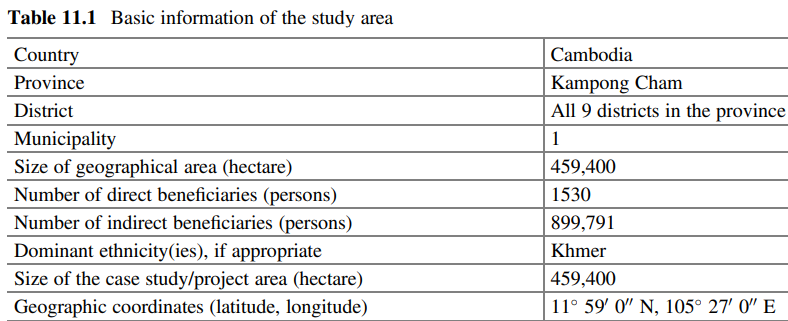
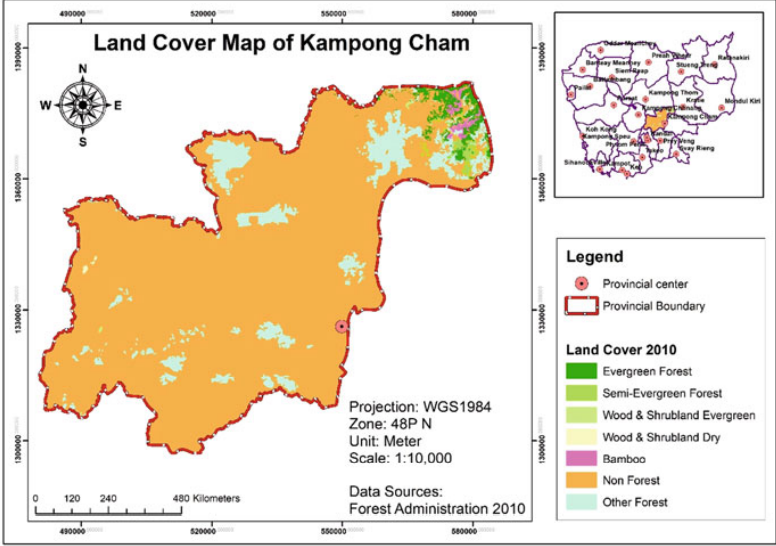
Although many farmers realise the adverse impacts of agrochemicals to human and environmental systems, they lack knowledge related to sustainable or alternative farming practices. Meanwhile, the agricultural extension officers who are responsible for enhancing farmers’ knowledge are simply not enough in number compared to their assigned areas (de Silva et al., 2014). Cambodia has suffered prolonged internal conflict that has ruined the educational system and social economy across the country, such that capacity-building of extension officers has not been implemented. Hence, interventions from change agents such as NGOs, civil society, or educational institutions are essential to tackle this problem. To address the aforementioned issues, the Institute of Environmental Rehabilitation and Conservation (ERECON) initiated the Project on Promoting Sustainable Agricultural Conditions for Poverty Reduction in Kampong Cham Province (September 2017 to February 2021) to enhance the capacity of extension officers and farmers, with a multi-stakeholder approach as the key approach. The project aimed to promote sustainable agricultural conditions through various forms of education for change agents (agricultural extension officers) and farmers in the province. The project covered all ten districts of the province. The specific objectives included:
- To build capacity on sustainable agriculture based on the cyclic use of natural resources in the Provincial Department of Agriculture, Forestry and Fisheries (PDAFF) and ten District Department of Agriculture, Forestry and Fisheries (DDAFF) of the province, including dissemination skills and knowledge ranging from soft (knowledge, skills) to hard (facilities) measures
- To promote sustainable farming practices based on the cyclic use of natural resources by local farmers
- To promote conditions for the sale of agricultural products with low chemical inputs
Although human health was not a main objective of the programme from the beginning, from April 2020 to February 2021 amidst the COVID-19 global pandemic, programme stakeholders observed that due to achievement of objective number two, some changes had occurred related not only to environmental but also human health.
2 Methodology
2.1 Multi-stakeholder Approach
Hemmati (2002) described the multi-stakeholder process as a tool to promote better decision-making by ensuring that the views of the main actors concerned about a particular decision are heard and integrated at all stages of dialogue and consensus building. The process takes the view that everyone involved in the process has a valid view and relevant knowledge and experience to bring to the decision-making.
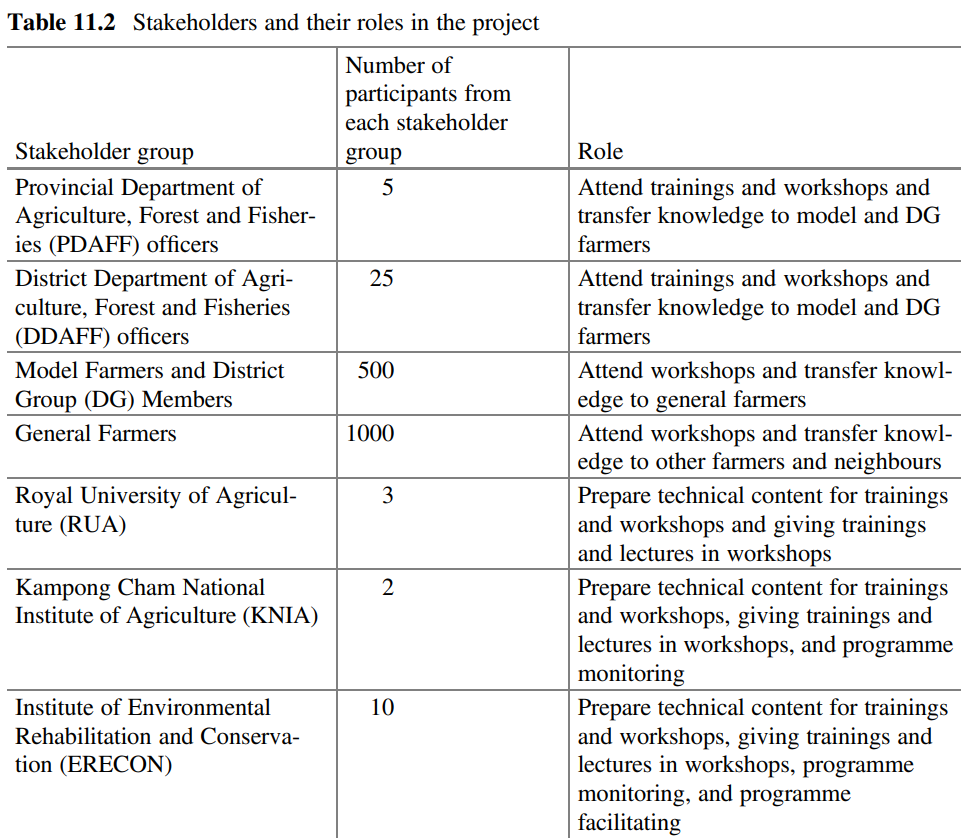
The approach aims to create trust between actors and solutions that provide mutual benefits (win-win). The approach is people-centred, with everyone involved taking responsibility for the outcome. When inclusive and participatory approaches are used, stakeholders have a greater sense of ownership of decisions made, and are thus more likely to comply with them. Stakeholders of the project included the Royal University of Agriculture (RUA), Cambodia; Provincial Department of Agriculture, Forestry and Fisheries (PDAFF), District Department of Agriculture, Forestry and Fisheries (DDAFF), Kampong Cham; Kampong Cham National Institute of Agriculture (KNIA); and farmers’ groups for promoting sustainable agriculture. The number of persons and the roles of each stakeholder group are presented in Table 11.2.
Trainings and workshops covered topics ranging from sustainable agricultural practices to product handling and marketing channels and were provided to extension officers and farmers by ERECON staff and RUA and KNIA lecturers, as presented in Table 11.3. Contents of training and workshops were prepared and delivered to PDAFF and DDAFF officers by ERECON staff and RUA and KNIA lecturers. The trained officers gave feedback on the content and delivery methods to lecturers and ERECON staff. The feedback was considered and incorporated into outreach materials before it was used with farmers, as shown in Fig. 11.2. The roughly 1500 farmers who attended the trainings and workshops were expected to share the knowledge gained with their neighbours. Agricultural materials, such as compost boxes and tanks for making liquid fertiliser and biopesticide, were distributed to all farmers along with guidebooks on sustainable agriculture practices. Networks for safe agricultural products were formed, and marketing channels for the products were introduced to farmers in the final year of the project through workshops and trainings. Small shops for selling low agrochemical input products were set up in the ten districts of the province, with products sold at the stalls coming from farmers who participated in the project. The main products included leafy vegetables, tomatoes, eggplants, cucumbers, etc.
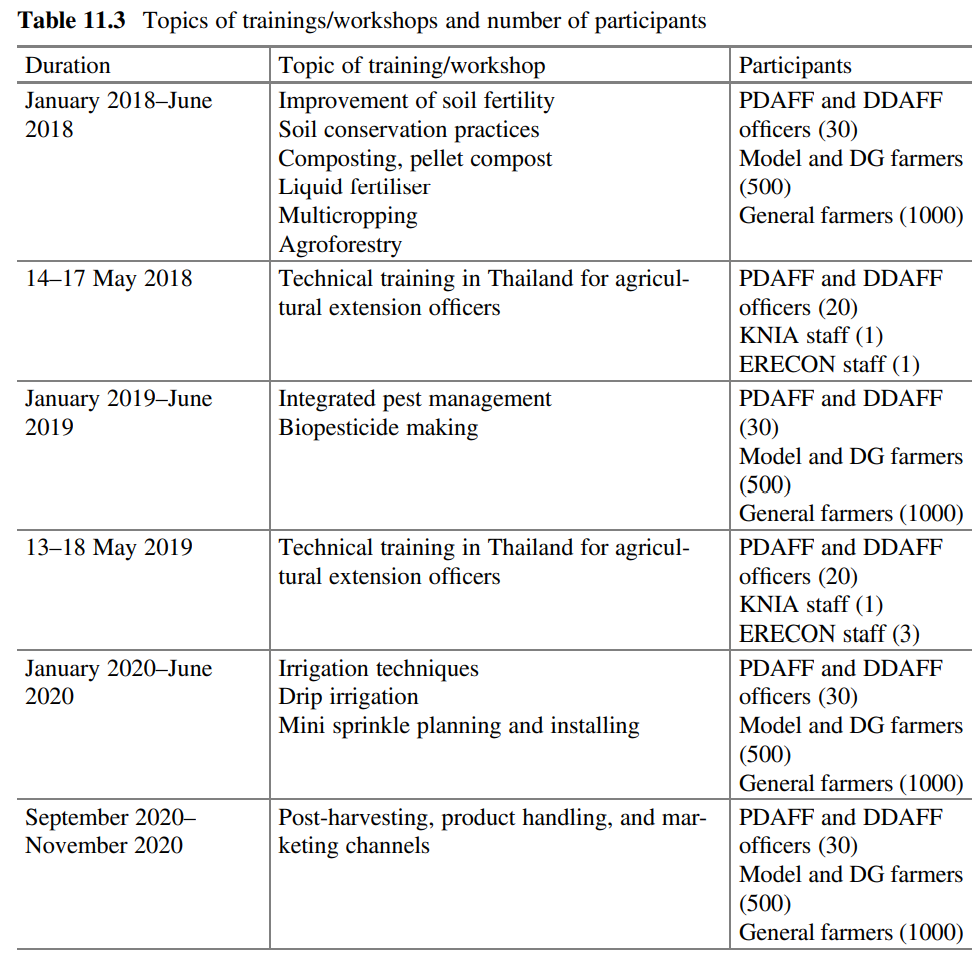
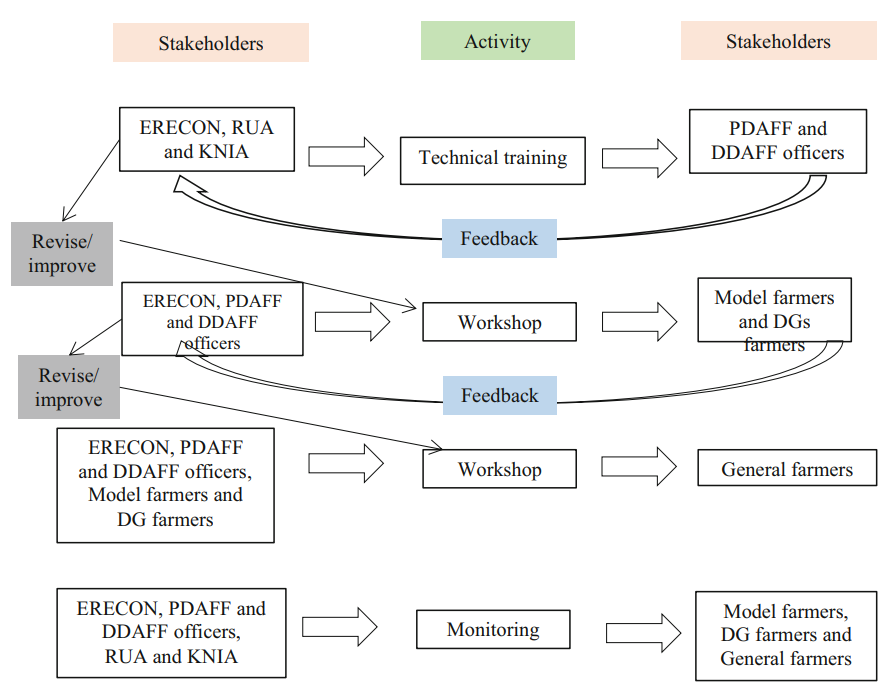
2.2 Data Collection and Analysis
A questionnaire survey, semi-structured interviews, focus group discussions, and programme monitoring through farm data records and farm visits by DDAFF officers and KNIA and ERECON staff were the methods used to collect data. Moreover, the concept of citizen science (McKinley et al., 2017; Ryan et al., 2018) was applied by asking farmers to observe and make note of changes observed in their farmlands after converting to organic fertilisers. DDAFF officers were assigned to make monthly visits to farmers participating in the project, make records of natural fertilisers produced and utilised in farmlands, and write monthly reports. To capture any changes following project implementation, 100 DG farmers who parti cipated in the project were randomly selected out of a total of 500 DG farmers to conduct baseline and end-line surveys. Descriptive statistics were used to analyse the data collected.
3 Results
From the first year of the project until project termination, more than 50 workshops were conducted for agricultural officers and farmers in the project area as shown in Table 11.4. Trainings and workshops for PDAFF and DDAFF officers were conducted at the provincial office. Officers working in the districts had to travel to the provincial capital to attend. For DG and general farmers, workshops were held at model farmers’ houses or at village meeting places as shown in Figs. 11.3 and 11.4. The average distance travelled to attend workshops was around 4 km.
According to the baseline and end-line surveys, 78.0% of respondents were male with an average age of 49.62 years old. Regarding educational attainment, 44.0% graduated primary school, and 39.0 percent graduated secondary school. The average number of family members was 5.12 persons, and the average years of residency in the respective districts were 43.04 years. The average cultivated land size was 1.19 ha with 72% fully irrigated. Main crops grown by the respondents included rice, cassava, corn, fruit trees, and vegetables.
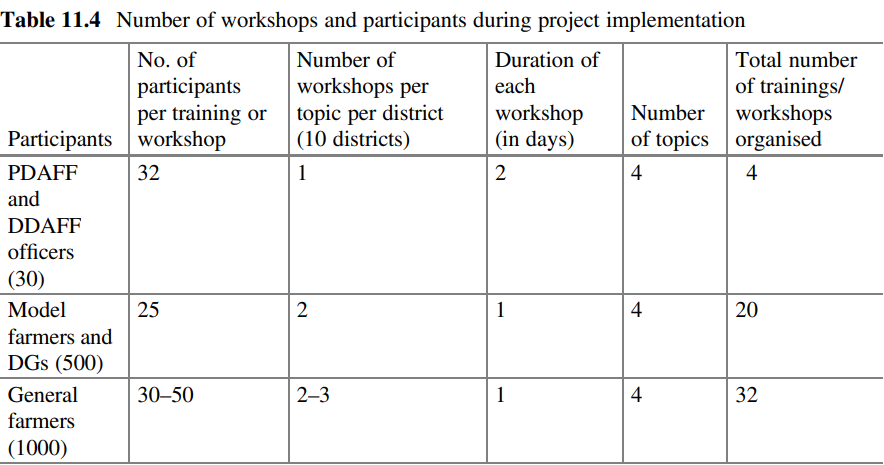
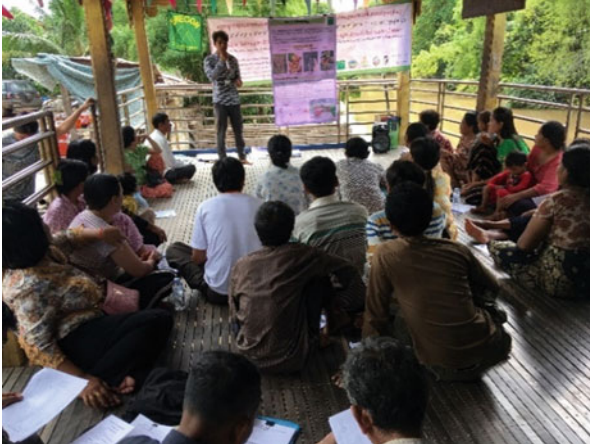
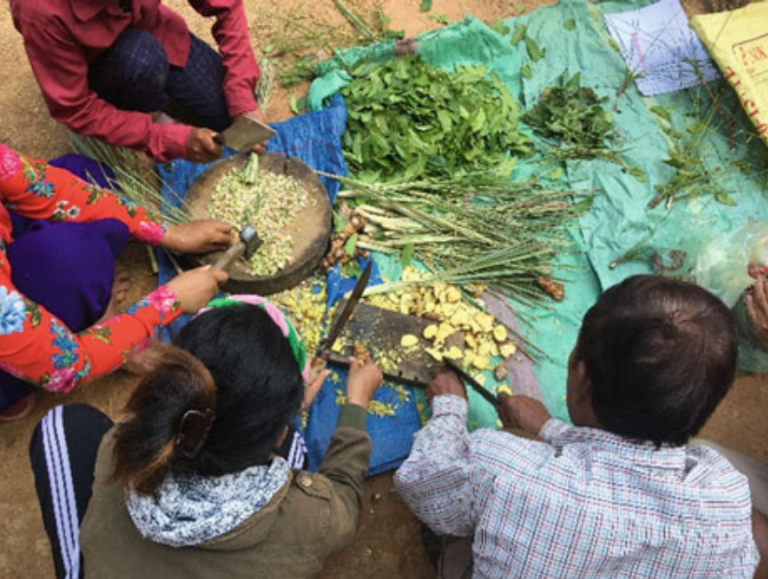
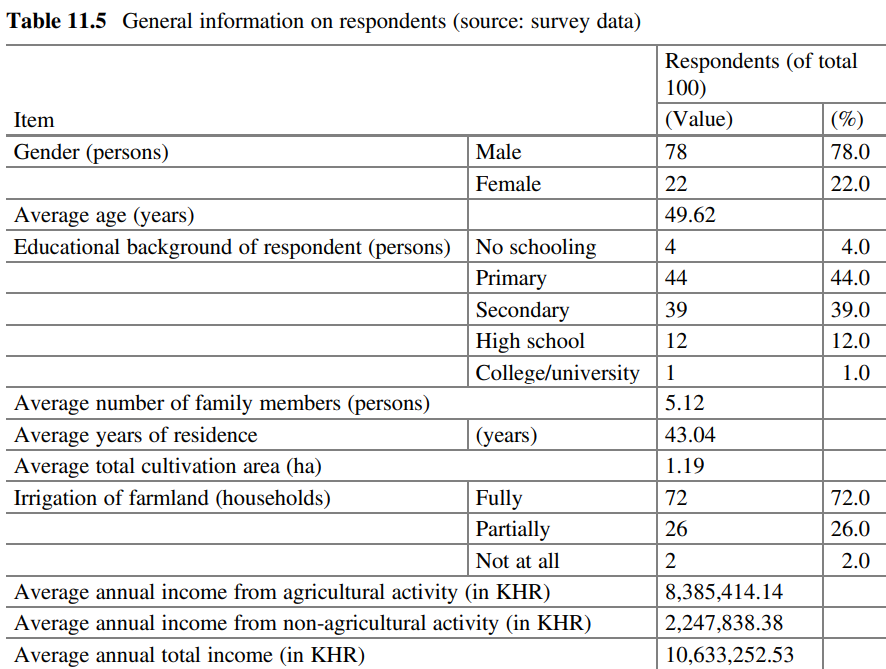
Even without any significant change in cropping area, end-line surveys showed that the farmers’ average annual income from agricultural activity increased by 49.9% or 3,683,141.41 KHR (Cambodian Riel, around 905 USD) from the year that the project started, pointing to an increased efficiency in the existing land use (Table 11.5). Income from non-agricultural activities also grew by 45.2% or 1,015,079.76 KHR (249.5 US$) over the 2-year period (2018–2020). One of the reasons for this increase was family members gaining income working in garment factories or working abroad sending remittances back to their families.
3.1 Changes in Agricultural Practices
Farmers who reported using chemical pesticides decreased overall by 9.0% from 90.0 to 81.0 percent. Of these, farmers using herbicides decreased by 9.0% from 54.0 to 45.0%, and those using insecticides decreased by 11.0% from 78.0 to 67.0%. Meanwhile, farmers who reported using organic pesticides increased by 39.0% from 23.0 to 62.0%. Similarly, farmers using chemical fertilisers decreased by 5.0 percentage points from 87.0 to 82.0% (Table 11.6).
The farmers who did not apply agrochemicals prior to joining the project stated reasons including lands being relatively small (less than one hectare) and a lack of any significant insect pest problems. They considered application of agrochemicals to be unnecessary.
Likewise, comparing with the baseline survey, end-line survey results showed that the number of farmers using organic fertilisers increased by 11.0% from 85.0 to 96.0%. Among organic fertilisers, the biggest increase was seen for compost, rising by 74.0% from 7.0 to 81.0%, followed by liquid bio-fertiliser rising 25.0% from 4.0 to 29.0%, and green manure with a 28.0% increase from 6.0 to 34.0%. Rice husk and/or bran went up 20.0% from 13.0 to 33.0%, rice straw 12.0% from 13.0 to 25.0%, and other organic fertilisers 6.0% from 2.0 to 8.0%. Of all organic fertilisers, only animal manure saw a relative decrease in use, falling by 7.0% from 80.0 to 73.0% due to farmers using it to make compost instead of applying it directly on their fields (Table 11.7).
The reason behind this drastic increase in organic fertiliser use was the farmers’ lack of knowledge in making organic fertilisers, such as compost or liquid fertiliser, before the project started. Prior to the project, the most prevalent practice was applying cow manure directly to farmlands, which carried the risk of pathogenic bacteria such as Escherichia coli leaking into water sources. Through participating in the project, farmers gained knowledge on how to make and apply compost and liquid fertiliser to their farmlands.
During the second year of the project, when some farmers started to grow low input or organic vegetables, compost became a necessary input for them. Many farmers changed their attitudes towards organic fertilisers, especially compost, after observing the good practices of their neighbours.
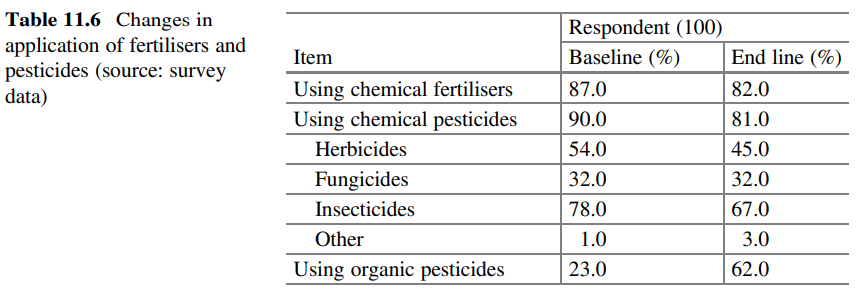
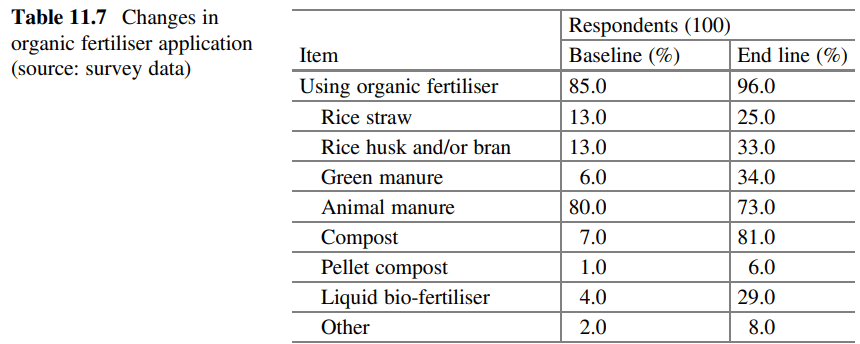
However, some farmers still apply chemical fertilisers mixed with compost in an attempt to get a quicker and higher yield than with compost alone. Some farmers have continued to decrease the amount of chemical fertilisers used while increasing the amount of compost. Chemical pesticides are still widely used in the project areas due to organic pesticides showing a lower performance than that of chemical pesticides, especially for farmers who grow large amounts of vegetables. Changing the perception of farmers concerning the adoption of organic fertiliser application by modelling the change proved to be very effective. In this case, the model farmers played important roles in sharing knowledge and using their farms as places for demonstration and showcasing of sustainable agricultural practices to their neighbours and visitors.
Regarding changes in soil conditions and diversity in farms, semi-structured interviews were conducted with ten model farmers. Excerpts from the interviews are presented below:
First thing I did is reduce chemical fertiliser and pesticide; after participate in the training, I clearly realise that applying chemicals is impacting health and the environment and costs much more money. That is the reason why I changed to using compost for which materials can be found around the house, and it’s cheaper. Second is I changed the traditional habit of growing; I used to grow crops for only household consumption and without much taking care. But now, that habit is changed, and I look after my crops and soil well. I can see the soil condition is improved after applying compost. —Farmer A
I can say, it (crop diversity) is increased 30% in my farms. I cultivate many types of vegetables, and I can produce foods for the year round. —Farmer B
Crop diversity in my farm is really increased. More than 50 dragon fruit trees are increased, and I plan to add another 30 trees this year. Moreover, I grow more crops for household consumption, like eggplant, tomato, lemongrass, and other herbs, etc. I also raise chickens, ducks and some catfish to gain more income. —Farmer A
Since I started applying bio-pesticide to my farmland, I found out there are many beneficial insect populations that have significantly increased. I noted that there are bees, spiders, golden bugs, and frogs, etc. —Farmer B
I noticed that after I started applying bio-pesticide, some beneficial insects appeared more, like bees and spiders. There are also birds and some types of reptiles coming to eat worms, ants, and other pests. Those insects and small animals never showed up when I used chemical pesticide. —Farmer C
Most farmers interviewed reported noticing improvements in soil conditions, such as soil being more porous, softer, and darker in colour compared to before applying organic fertilisers. Farmers also reported that they increased crop diversity in their farmlands with multiple benefits, such as producing for household consumption, for the market, or to use as safety nets (in the case of animal husbandry). Moreover, more beneficial insects were found in farmlands after farmers stopped applying chemical pesticides and began using biopesticides made from plants and herbs in their farmlands.
3.2 Impact of COVID-19
Kampong Cham is one of the provinces with reported cases of COVID-19, with 118 cases as of 4 May 2021 (Ministry of Health (MoH), 2021). Due to the global pandemic, several planned workshops and trainings had to be postponed because the Royal Government of Cambodia restricted all events involving more than 50 participants. The postponed activities have caused a delay in project implementation, especially in the flood-prone areas along the Mekong River, which are normally difficult to access during the rainy season. During this hardship, several organisations working in the country decided to hold workshops, seminars, or meetings using internet platforms to connect people. However, most of the project beneficiaries are farmers living in rural and remote areas with limited access to infrastructure such as tap water or electricity, let alone smartphones to connect to the internet. Most of the farmers participating in the project own mobile phones, but only 25% own smartphones. Some farmers reported that although at least one of their family members owns a smartphone, they themselves do not know how to use it. Face-to-face communication and social gatherings are still the most effective means of communication with farmers, especially in remote areas. Therefore, local stakeholders, especially agricultural extension officers, model farmers, and district group members, play important roles in project monitoring and keeping the majority of farmers engaged in the project via farm visits and mobile phone conversations. A questionnaire survey for DG and model farmers and semi-structured interviews were conducted to obtain updates on farmers’ situations during the pandemic, especially on their feelings about their own health, food security, and mental health. A total of 58 DG farmers completed the survey between January and May 2021. Results are shown in Table 11.8.
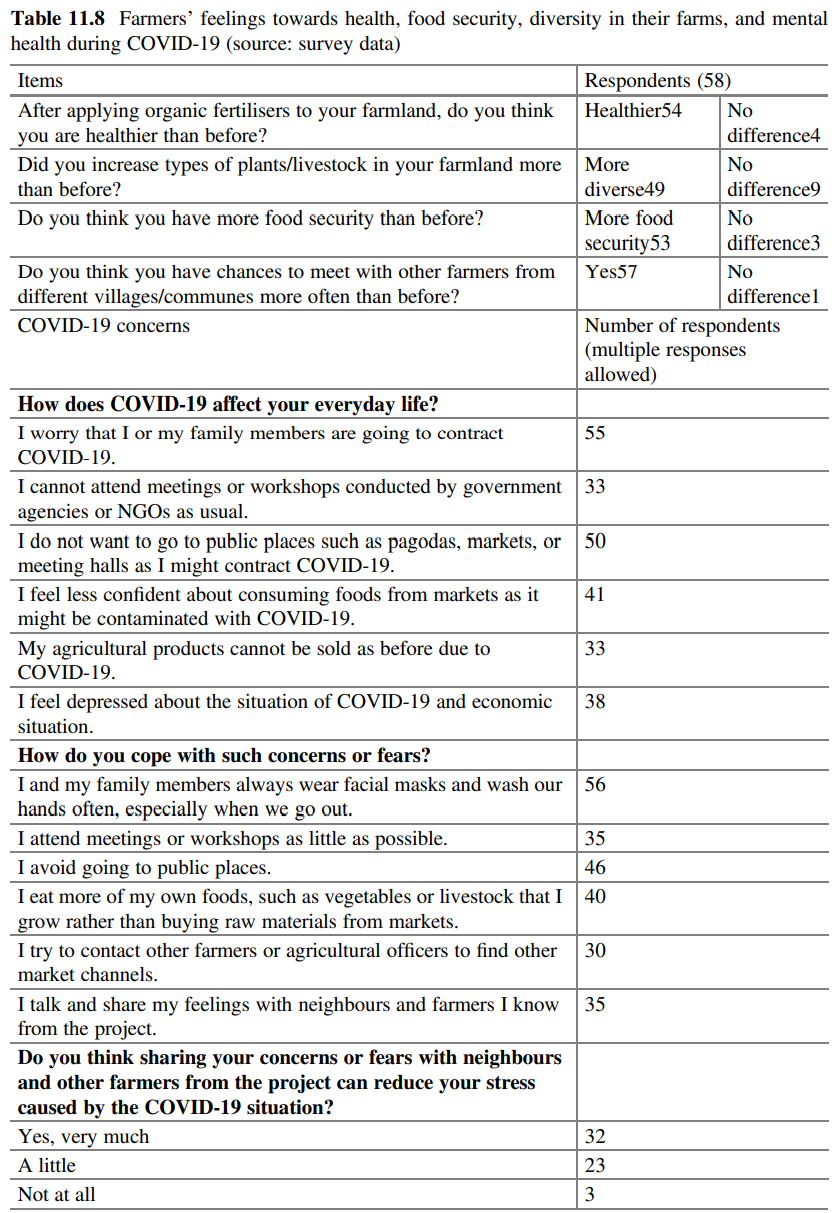
Some responses from interviews with farmers are presented below:
Since COVID-19, I am only confident in consuming food collected from my own farm. And I do not usually buy from outside, only meats and other necessary ingredients. I can rely on my farm to survive during the pandemic. —Farmer D
Since the COVID-19 outbreak, I am more confident eating my own food from my farm rather than going out to eat or buying vegetables from unknown sources. Because I only apply compost, liquid fertiliser and bio-pesticide I have learnt from ERECON about my crops. Our community members also know how to prevent themselves from contracting COVID-19 by following the Ministry of Health’s announcements. Many of them diversified their farms to meet household consumption and meet the market demand. But at the same time, their products do not sell well, because of the reduction of buyers/consumers. —Farmer E
Most of the farmers interviewed stated that during the pandemic, they felt more confident consuming their own products, believing that they could depend on their own crop diversity. Meanwhile, they felt less stress after talking and exchanging information among community members. Results of interviews clearly show that sustainable agricultural practices lead to healthy soil and healthy and safe foods and contribute to human health, both of the individual and the community
4 Challenges and Opportunities
4.1 Challenges
During the 3 years of the project intervention, the number of farmers using organic fertilisers has increased, but the use of chemical fertilisers mixed with compost is still prevalent, although the amount of chemical fertiliser is small compared to compost. Project staff and agricultural extension officers suggested farmers to gradually decrease the amount of chemical fertilisers and increase the amount of compost. Moreover, the biopesticides introduced by the project were not highly adopted by some farmers, especially those engaged in mono-crop farming, as they are less effective compared to chemicals. Positive human and institutional impacts were seen as extension officers gain knowledge, skills, and experience in agricultural extension and advisory services from agricultural development projects/programmes (Ke & Babu, 2018). However, the number of agricultural extension officers assigned to work in each district is still small considering the size of the areas for which they are responsible. This challenge is also discussed in the work of Sothath and Sophal (2010), who note that the average of extension service support in Cambodia at the district level is 5000 households per extension worker. This limitation is an obstacle for farmers to obtain adequate knowledge of sustainable farming practices.
4.2 Opportunities
Sustainable organic farming has become one of the province’s agricultural extension policies. The project has contributed to provincial and district agricultural strategic plans by promoting the production of low agrochemical input or organic products by farmers in the province for supply to local markets. Moreover, the project has also enhanced food security at the household and community level through increased crop diversity and productivity. Organic farming and safer foods are well accepted by relevant stakeholders, especially customers in the province. Several farmers involved in the project produced low agrochemical input products or organic products, which earned 20 to 25 percent higher a price than that of conventional products. Figure 11.5 shows the organic vegetable farm belonging to one of the DG farmers, which received a net house from another project as part of an integrated pest management (IPM) technique promotion activity. The farmer has successfully applied IPM techniques and demonstrated the benefit of selling low-chemical input products at higher prices. This case serves as a good example that can motivate more farmers to follow a similar path. Enhanced engagement of youth and educational institutes was also observed. The project stakeholders included two educational institutes, one located in the capital city of Phnom Penh and the other located in Kampong Cham Province, the Kampong Cham National Institute of Agriculture, which actively engaged in the project by conducting farm visits and collaborating with farmers using their farms as experimental sites for students. Sharing knowledge with university students made the farmers more confident in their farming practices. Moreover, the project also encouraged young farmers to get involved and use their knowledge of and access to social media to support older farmers in keeping up with news on techniques and other information related to sustainable agricultural practices.
During project implementation, we observed the active involvement of women. Several of them supported the extension officers during trainings and workshops by sharing their knowledge and first-hand experiences in applying organic fertilisers or other changes in their farms with other farmers as well with visitors from universities and government agencies (Fig. 11.6). Several PDAFF and DDAFF officers acknowledged that through this project, they acquired new knowledge and techniques on sustainable farming practices used both in Cambodia and abroad. The technical trainings in Thailand, in particular, motivated many officers to develop conditions for sustainable farming practices in their own responsible areas. Moreover, the knowledge dissemination design that required officers to give lectures to farmers in the workshops gave junior officers the opportunity to hone their teaching and communication skills instead of only observing senior officers perform.
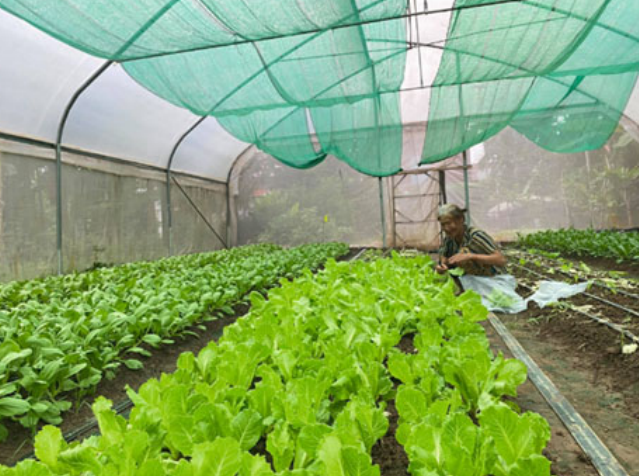
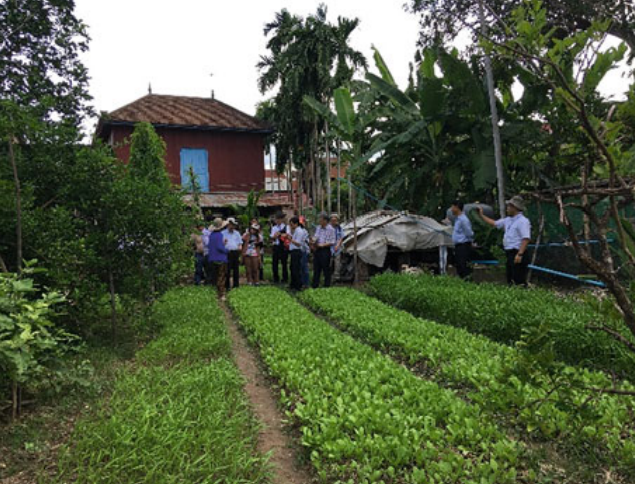
5 Conclusion
After 3 years of project implementation, several changes and developments in terms of agricultural practices and the capacities of officers and farmers were observed. According to monitoring reports and farm visits, farmers produced and applied compost, liquid fertilisers, and biopesticides in their farmland instead of agrochemical products. The changes resulted in an increase in agricultural biodiversity in farmlands and enhanced food security and human health.
The project has contributed to provincial and district agricultural strategic plans by promoting the production and sale in markets of low-agrochemical-input or organic products by farmers in the province. Although the progress of marketing organic products was hindered by COVID-19, knowledge in marketing and networks were formed. Moreover, consumers in the Kampong Cham capital city became aware of organic farming networks through the promotional event held by PDAFF.
Through its multi-stakeholder approach, the project addressed Target 2.4 for Goal 2 of the SDGs, by promoting sustainable food production systems to increase productivity and production, and improve land and soil quality. The project covered the whole province encompassing various landscapes ranging from uplands to lowlands and river ecosystems. The sustainable agricultural practices promoted and applied by farmers in these landscapes have helped to conserve the soil and water ecosystems and have resulted in improved human health.
The project also contributed to Target 12.2 for Goal 12, by promoting sustainable management and efficient use of natural resources through composting and producing organic fertilisers. Generally, after rice is harvested from paddies, rice straw is collected and used as animal fodder. However, farmers always burnt the remaining rice stumps as a convenient way to clear the land before the next growing season. Burning residue not only creates smoke and particulate matter (PM2.5), but also kills microorganisms and animals in the soil (Ajay et al., 2019). Using farm residues to make compost to apply to fields is a good example of cyclic use of resources for sustainable production and consumption. Although more labour by farmers is required to make and apply compost than needed for the use of chemical fertilisers, the practices result in a better environment and improved human health both at the individual and community levels.
Farmers who converted their agricultural practices from applying agrochemical products to using organic fertilisers observed several changes in their farmlands. For instance, some noted the improvement of soil conditions, such as more porous soils that are darker in colour and contain more soil organisms. The integrated pest management also allowed more beneficial insects to live, helping control insect pests. Crop diversity in farmlands enhanced the food security of farmers, which has proven to be vital especially during the COVID-19 pandemic.
It is anticipated that understanding and awareness of sustainability, especially with regard to consumption and production, will spread to the public in Kampong Cham Province through the farmers’ network. We also expect that the outcomes from this project will be scaled up and applied to broader areas of Cambodia.
References
Ajay, K., Kushwaha, K. K., Singh, S., Shivay, Y. S., Meena, M. C., & Nain, L. (2019). Effect of paddy straw burning on soil microbial dynamics in sandy loam soil of indo-gangetic plains. Environmental Technology & Innovation, 16, 100469.
Crowder, D. W., Northfield, T. D., Strand, M. R., & Snyder, W. E. (2010). Organic agriculture promotes evenness and natural pest control. Nature, 466, 109–112.
de Silva, S., Johnston, R., & Sellamuttu, S. S. (2014). Agriculture, irrigation and poverty reduction in Cambodia: Policy narratives and ground realities compared, CGIAR Research Program on Aquatic Agricultural Systems, Penang, Malaysia, Working Paper AAS-2014-3.
EuroCham. (2016). Agriculture and agro-processing sector in Cambodia, taking stock: A detailed review of current challenges and investment opportunities in Cambodia. EuroCham, AgriProject Reporting, v. 46.
Eyhorn, F. (2007). Organic farming for sustainable livelihoods in developing countries: The case of cotton in India. PhD dissertation, Department of Philosophy and Science, University of Bonn. FAOSTAT. (2021). Pesticides trade, viewed 15 October 2021. Retrieved from https://www.fao.org/ faostat/en/#data/RT.
Forest Administration. (2010). Land cover map of Kampong Cham. Ministry of Agriculture, Forestry and Fisheries.
Institute of Environmental Rehabilitation and Conservation (ERECON). (2018a). Workshop on composting.
Institute of Environmental Rehabilitation and Conservation (ERECON). (2018b). Training on bio-pesticides.
Institute of Environmental Rehabilitation and Conservation (ERECON). (2021). Organic vegetable farm of a DG member.
Institute of Environmental Rehabilitation and Conservation (ERECON). (2019). A farmer showing her organic garden to visitor.
JICA. (2010). Kingdom of Cambodia, study for poverty profiles in the Asian region, final report, Japan International Cooperation Agency, OPMAC Corporation.
Ke, S. O., & Babu, S. C. (2018). Agricultural extension in Cambodia: An assessment and options for reform. IFPRI discussion paper 01706. International Food Policy Research Institute
Hemmati, M. (2002). Multistakeholder processes for governance and sustainability. Earthscan.
Lotter, D. W. (2003). Organic agriculture. Journal of Sustainable Agriculture, 21(4), 59–128.
McKinley, D. C., Miller-Rushing, A., Ballard, H. L., Bonney, R., Brown, H., Cook-Patton, S. C., Evans, D. M., French, R. A., Parrish, J. K., Phillips, T. B., Ryan, S. F., Shanley, L. A., Shirk, J. L., Stepenuck, K. F., Weltzin, J. F., Wiggins, A., Boyle, O. D., Briggs, R. D., Chapin, S. F., III, … Soukup, M. A. (2017). Citizen science can improve conservation science, natural resource management, and environmental protection. Biological Conservation, 208, 15–28.
Ministry of Agriculture, Forestry and Fisheries (MAFF). (2012). Annual report of agriculture for 2011–2012.
Ministry of Environment (MoE). (2004). National profile on chemicals management in Cambodia.
Ministry of Environment (MoE). (2010). Unsustainable agricultural practices (unpublished handout, Cambodia National Environmental Performance Assessment (EPA) at Sunway Hotel
Ministry of Health (MoH). (2021). COVID-19 statistics, communicable disease control department, viewed 4 May 2021. Retrieved from https://covid19-map.cdcmoh.gov.kh/?fbclid¼IwAR2 9DjPwYCLbkqtreXbXnRgsAVjOqEAA0HnX96NQnLLdeT4XKep_PDwH-3U (In Khmer language).
Paavo, E., & Sergiy, Z. (2015). Cambodian agriculture in transition: Opportunities and risks. World Bank Group.
Royal Government of Cambodia. (2019). General population census of the kingdom of Cambodia 2019. National Institute of Statistics, Ministry of Planning.
Ryan, S. F., Adamson, N. L., Aktipis, A., Andersen, L. K., Austin, R., Barnes, L., Beasley, M. R., Bedell, K. D., Briggs, S., Chapman, B., Cooper, C. B., Corn, J. O., Creamer, N. G., Delborne, J. A., Domenico, P., Driscoll, E., Goodwin, J., Hjarding, A., Hulbert, J. M., … Dunn, R. R. (2018). The role of citizen science in addressing grand challenges in food and agriculture research. Proceedings of the Royal Society B, 285(1891), 20181977. https://doi.org/10.1098/ rspb.2018.1977
Smith, S. J., Schepers, J. S., & Porter, L. K. (1990). Assessing and managing agricultural nitrogen losses to the environment. Advances in Soil Science, 14, 1–32.
Sothath, N., & Sophal, C. (2010). Agriculture sector financing and services for smallholder farmers, NGO Forum on Cambodia.
Note
The opinions expressed in this chapter are those of the author(s) and do not necessarily reflect the views of UNU-IAS, its Board of Directors, or the countries they represent.
Open Access This chapter is licenced under the terms of the Creative Commons Attribution 3.0 IGO Licence (http://creativecommons.org/licenses/by/3.0/igo/), which permits use, sharing, adaptation, distribution and reproduction in any medium or format, as long as you give appropriate credit to UNU-IAS, provide a link to the Creative Commons licence and indicate if changes were made.
The use of the UNU-IAS name and logo, shall be subject to a separate written licence agreement between UNU-IAS and the user and is not authorised as part of this CC BY 3.0 IGO licence. Note that the link provided above includes additional terms and conditions of the licence.
The images or other third party material in this chapter are included in the chapter’s Creative Commons licence, unless indicated otherwise in a credit line to the material. If material is not included in the chapter’s Creative Commons licence and your intended use is not permitted by statutory regulation, or exceeds the permitted use, you will need to obtain permission directly from the copyright holder.

